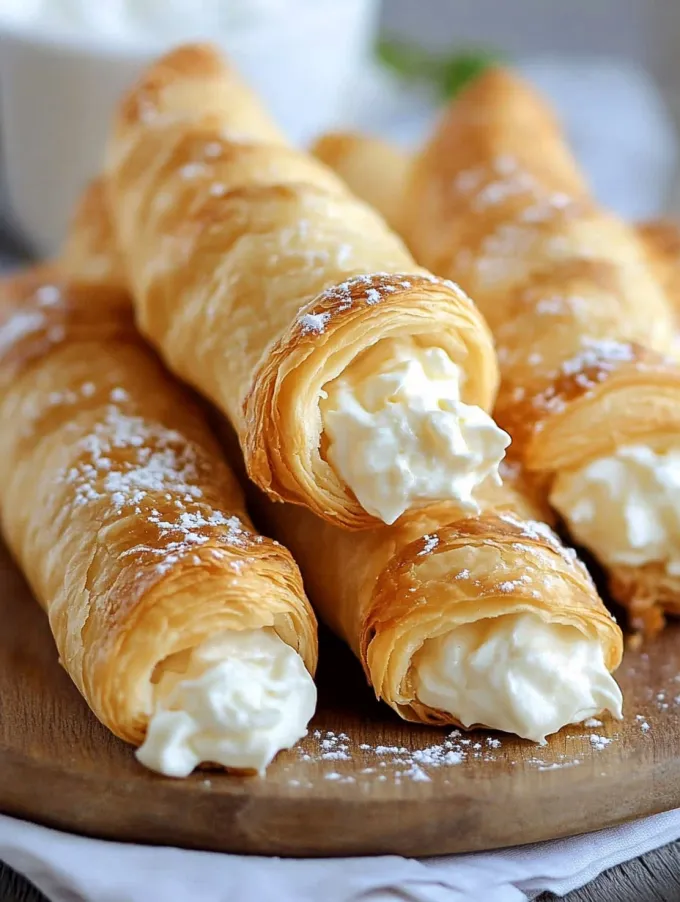 Pin it
Pin it
The moment you bite into a freshly filled Cannoncino, the contrast between crisp, flaky pastry and silky custard creates a magical experience. These elegant Italian pastry horns have become my signature dessert for gatherings, transforming simple ingredients into something that feels truly special. Through countless batches, I've discovered that temperature control and patience are the keys to achieving that perfect balance of textures.
Last Sunday, I served these at a family dinner, and my nephew, who typically avoids desserts, ate three in a row. The secret lies in allowing the custard to properly set and the pastry to cool completely before filling.
Essential Ingredients and Selection Tips
- Puff Pastry: All-butter varieties create the flakiest results. Thaw completely but keep cold
- Egg Yolks: Farm-fresh yolks give the custard a deeper color and richer flavor
- Milk: Whole milk creates the creamiest texture. Don't substitute with lower-fat versions
- Vanilla: Pure extract or a real vanilla bean creates the most authentic flavor
- Sugar: Fine granulated sugar dissolves evenly in the custard
 Pin it
Pin it
Detailed Cooking Instructions
1. Perfect the Custard
- Step 1:
- Whisk egg yolks and sugar until pale yellow and noticeably thicker
- Step 2:
- Add flour gradually, sifting to prevent lumps
- Step 3:
- Heat milk just until bubbles form around the edges
- Step 4:
- Temper egg mixture by adding hot milk slowly while whisking constantly
- Step 5:
- Cook over medium-low heat, stirring continuously until thickened
2. Master the Pastry
- Step 1:
- Keep pastry cold until ready to use
- Step 2:
- Roll on sugar to create a caramelized exterior
- Step 3:
- Cut strips with a sharp knife or pizza cutter for clean edges
- Step 4:
- Overlap pastry slightly when wrapping around molds
- Step 5:
- Press ends firmly to seal
3. Achieve Perfect Assembly
- Step 1:
- Cool horns completely before removing from molds
- Step 2:
- Chill custard with plastic wrap directly on surface
- Step 3:
- Fill horns from both ends for complete custard in every bite
- Step 4:
- Use a proper pastry bag with a medium round tip
My first attempt at these pastries taught me the importance of properly tempering the eggs - rushing this step leads to scrambled eggs rather than silky custard.
Temperature Control
Keeping the pastry cold is crucial for achieving those beautiful layers. If it becomes too warm at any point, return it to the refrigerator for 15 minutes before continuing.
Make-Ahead Strategy
I often prepare the custard and bake the horns a day in advance, then fill them just before guests arrive. This approach ensures the perfect texture contrast.
Storage Solutions
Store unfilled horns in an airtight container with parchment between layers to maintain crispness. They can be refreshed in a warm oven for a few minutes before filling.
 Pin it
Pin it
Final Thoughts: These Italian Cream Stuffed Cannoncini represent the beautiful simplicity of Italian pastry - few ingredients transformed through proper technique into something extraordinary. The combination of crisp, sugar-dusted pastry and rich vanilla custard creates a dessert that's both elegant and comforting. Whether served at a special occasion or simply to elevate an everyday meal, these pastry horns never fail to delight.
Frequently Asked Questions
- → What if I don't have horn-shaped molds?
- You can make your own by wrapping aluminum foil around the handle of a wooden spoon, or purchase metal cream horn molds online.
- → Can I make these ahead of time?
- Yes, both components can be prepared ahead. Store unfilled pastry shells in an airtight container for 1-2 days, and custard in the refrigerator for up to 3 days. Fill just before serving.
- → Why is my custard lumpy?
- This typically happens if the egg mixture cooks too quickly. Whisk constantly and cook over medium-low heat. If lumps form, strain the custard through a fine-mesh sieve.
- → Can I flavor the custard differently?
- Absolutely! Add lemon zest, orange extract, almond extract, or even a splash of liqueur like Grand Marnier for different flavor profiles.
- → Why should I avoid getting egg wash on the molds?
- Egg wash can cause the pastry to stick to the molds, making them difficult to remove after baking.
